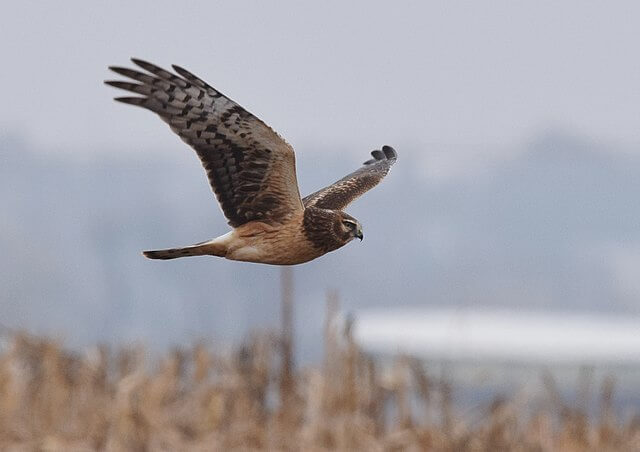Coming to My Senses with Northern Harriers
By Mark Armstrong
Broadcast 5.31 & 6.3.2023

Photo by Andy Reago & Chrissy McClarren, CC by 2.0.
Listen:
I have a confession to make. For years, I was obsessed with the goal of capturing photos of Northern Harriers. I chased these magnificent raptors on hikes near our home in the Bitterroot Valley, along irrigation ditches bordering ranchland, in parks, and at wildlife refuges.
Each time I left home to go birding, I was excited to observe and capture photos of a variety of birds. But, deep down, the ultimate prize I envisioned was a photo of a harrier – not just a photo that would confirm a sighting of a harrier, but one that would produce a crisp, clear image that would stop action in flight and show the “shine of the eye.”
Northern Harriers are considered one of the most elusive raptors, and some of the most accomplished wildlife photographers admit how difficult they are to photograph. Male harriers, with their white underside and opaque gray plumage, seem to be even more challenging to photograph than the brown and much larger females. For that reason, many birders and photographers call male harriers “Gray Ghosts.” One moment, they’re in your viewfinder—the next, they’re gone.

Northern Harrier hovering. Photo by Andy Reago & Chrissy McClarren, CC by 2.0.
My first encounter with a harrier was on a summer day while walking our three border collies along the irrigation ditch. Flying over hundreds of acres of sagebrush, a female harrier, with her chestnut-brown plumage, hovered in midair like a helicopter. With deep-dish, owl-like faces, harriers hunt by sound, just like owls. They are the only hawks that come close to the unparalleled hearing of owls, hovering above their prey before diving in for the kill. After a glorious and cinematic dive, she came up from the sagebrush with a rodent in her talons, probably a vole. The drama unfolded nearly 500 yards away. It would be as close as I would get to a harrier for years.
After trying—and failing—to capture and document my observation of harriers, I finally realized it was time to change my approach. I’m beginning to understand that these beautiful creatures deserve my respect. They’re not just another notch on my birding belt.
Harriers are teaching me to go deeper with my approach to birding. The years of chasing harriers have helped me sharpen my naturalist skills: taking notes, observing, being patient, learning from other naturalists. I’ve accepted that this is a long game, not a quick photo.
The more I observed and researched, the more fascinated I became. For example, unlike most raptors, harriers nest on the ground. They hunt in open prairies but are also adept at hunting and nesting in marshlands. For that reason, they are often called marsh hawks. One of the most fascinating facts about harriers is they often coexist in winter with Short-eared Owls. The two species have a lot in common. They search for the same prey in the same habitat, and their hunting strategies are similar. Perhaps they are willing to live near each other only if there is an abundance of prey. Harriers take the day shift and Short-eared Owls take the night shift.
With spring finally returning to the Bitterroot Valley, I have come to my senses, literally and figuratively. On a recent day at Lee Metcalf National Wildlife Refuge, my wife and I sat for hours watching three male harriers sparring in the sky—a battle royale that would decide which raptor would win the prize of a mate. A few days later when we returned, we witnessed a courting sky dance. The male and female harriers performed an acrobatic dance 500 feet in the sky, executing their loops and dives again and again against the afternoon sun.
The harriers were comfortable with us at this distance, and we felt fortunate to observe them in their world. I snapped a few blurry distance shots, but the experience will always remain clear in my mind.
Every week since 1991, Field Notes has inquired about Montana’s natural history. Field Notes are written by naturalists, students, and listeners about the puzzle-tree bark, eagle talons, woolly aphids, and giant puffballs of Western, Central and Southwestern Montana and aired weekly on Montana Public Radio.
Click here to read and listen to more Field Notes. Field Notes is available as a podcast! Subscribe on Apple Podcasts or wherever you listen to podcasts.
Interested in writing a Field Note? Contact Allison De Jong, Field Notes editor, at adejong [at] montananaturalist [dot] org or 406.327.0405.
Want to learn more about our programs as well as fun natural history facts and seasonal phenology? Sign up for our e-newsletter! You can also become a member and get discounts on our programs as well as free reciprocal admission to 300+ science centers in North America!












